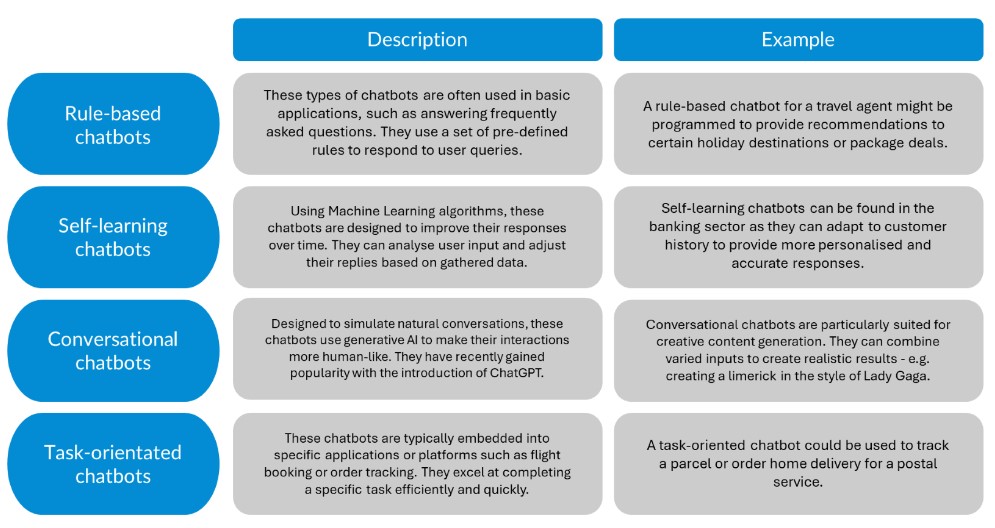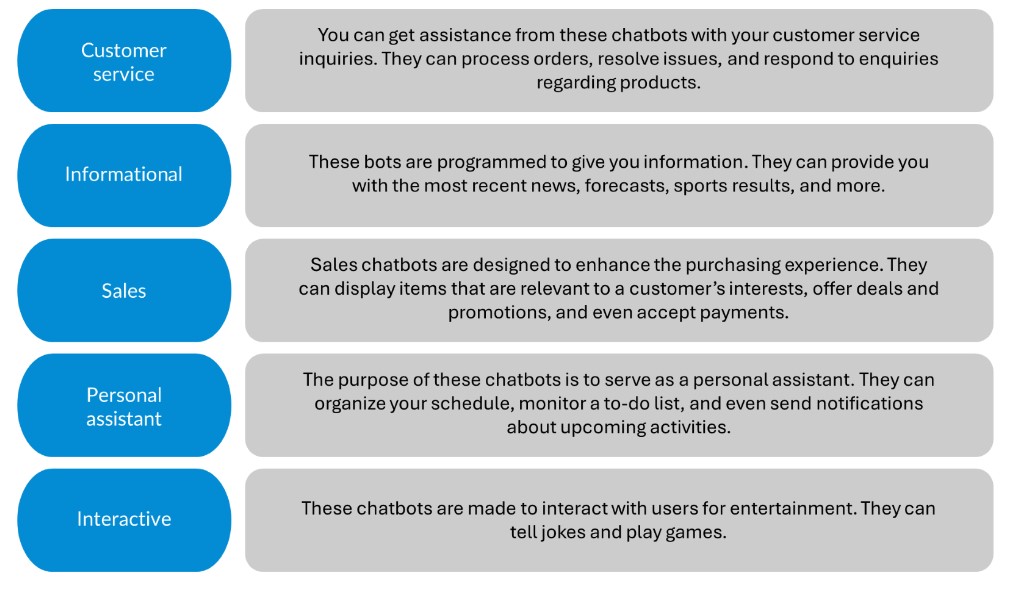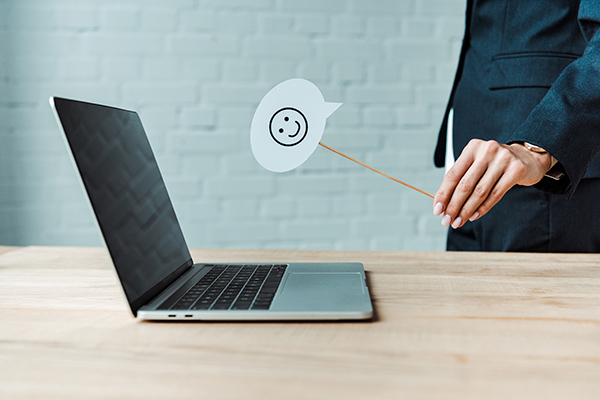A chatbot is a computer program that simulates a conversation with a user in order to convey information or carry out a certain task.
Chatbots are frequently used in customer service and support functions because they can easily manage repetitive enquiries at scale and guide users to quick, efficient answers.
To understand and respond to user input, some chatbots use artificial intelligence in the form of machine learning and natural language processing. When a user types or speaks a query or request, the chatbot analyses the input using these algorithms and chooses the best response. The user is then given this response, commonly in the form of text or speech.
Some chatbots can handle more complicated interactions by combining pre-programmed responses and machine learning to deliver more accurate and personalised responses.
Websites, messaging applications, and virtual assistants are among the variety of platforms that can incorporate chatbots, making them readily accessible to users. They are frequently used in sectors including banking, insurance, travel, and retail, where they can offer users quick and effective support and enhance the entire user experience.
Typical chatbot use cases include:
- Providing customer service and support.
- Answering FAQs.
- Guiding users through transactions or processes.
- Collecting data from users to better understand their needs.
- Providing personalised recommendations.
As modern companies continue to seek to automate customer service and support, chatbot technology is becoming increasingly commonplace, taking on a variety of forms but most commonly appearing as a chat window that pops up when you visit a website.
In recent years, chatbots have grown in popularity as a simple and affordable means for businesses to communicate with customers and deliver assistance and information. By asking questions and responding to users’ input, chatbots can simulate a real-life conversation, making them an increasingly popular choice for businesses looking to automate customer service.
Let’s take a look at what chatbots are, how they work and the benefits they provide for businesses, employees and consumers.
What kinds of chatbots are there?
The are many different kinds of chatbots – some designed to help with customer service and sales enquiries, while others specifically assist employees within an organisation.
These various types of chatbots can be split into four main archetypes that each have their own unique features and capabilities.
Here’s an overview of how chatbots work in practice and the four most common types:

What kinds of chatbot technologies?
In addition to the four chatbot archetypes above, the use cases for chatbot technology can also vary.
Here are some of the most common use cases for chatbots:

A Brief History of Chatbots
The history of chatbots can be traced back to the mid-1960s, when ELIZA, one of the first chatbots ever created, was invented by Joseph Weizenbaum at MIT. ELIZA was designed to imitate a therapist’s responses in order to provide therapeutic support to patients.
In 1972, PARRY became one of the first chatbots designed to beat a human opponent in a Turing test. PARRY was based on the paranoid schizophrenic hallucinations of its creator, Wellington Lee.

Since then, chatbots have come a long way, evolving from simple pattern-matching programs to mainstream adoption in the early 2000s on services like AOL and MSN Messenger.
In 2016, the widespread adoption of chatbots exploded when Facebook announced that it would begin allowing bots onto its popular messaging platform. By 2018, there were more than 300,000 active chatbots on Facebook Messenger.
In recent years, chatbot technology has advanced rapidly due to advances in artificial intelligence and natural language processing. Today’s chatbots are more sophisticated than ever and are being used in a variety of applications ranging from customer service to marketing to healthcare.
With the rapid advancement of artificial intelligence, the potential applications of chatbots are varied and exciting.
The Difference Between Bots and Chatbots
While similarly named, the difference between the two is simple: bots are computer programs that are designed to automate simple tasks, while chatbots are a type of bot that interacts with humans in a chat interface.
The term “chatbot” is derived from the word “chatterbot,” which was first used in 1966.
Chatbots are commonly used to simulate human conversation by responding to questions with pre-written or pre-programmed answers. They can be used for a variety of purposes, such as customer service, marketing, and even entertainment and are typically powered by artificial intelligence (AI) and natural language processing (NLP) technologies.
While chatbots and bots both involve the automation of tasks, chatbots are specifically designed to interact with humans. Bots are traditionally more related to technologies like Robotic Process Automation (RPA) which takes care of repetitive back-office tasks without the need to interact with humans directly.
How is AI Making Chatbots Better?
As chatbots become more sophisticated, they are beginning to rely less on rule-based programming and more on artificial intelligence. This shift towards AI-powered chatbots is making them smarter and more capable of handling complex enquiries.
AI is making chatbots smarter by allowing them to understand and process natural language more effectively. In the past, chatbots were limited to responding to pre-programmed commands and keywords, but modern AI chatbots are able to understand the meaning behind the words and phrases that are used in conversation. This allows them to provide more relevant and appropriate responses, resulting in more natural and human-like conversations.
AI chatbots are also able to learn from their interactions with users. As they engage with more people, they can understand their preferences and interests. By understanding the behaviour patterns of users, modern chatbots can dynamically tailor their responses to provide more personalised interactions.
It is also possible to integrate AI chatbots with other systems and platforms, not just with social media networks and messaging apps, but also with powerful backend systems for large businesses.
As a result of these advantages, AI is quickly becoming the default method for powering chatbots, enabling them to provide a wider range of services and be far more useful overall for users and businesses.
The Benefits of Chatbots
Chatbots are a great way for businesses to connect with their customers. They provide an always-accessible way for customers to get help with simple tasks, and they can also be used to provide marketing and sales information. In addition, chatbots are an effective way to build brand loyalty.
Some major chatbot benefits include:
- Chatbots are a great way for businesses to connect with their customers.
- They provide a fast, easy, and convenient way for customers to get help with simple tasks.
- They can also be used to provide marketing and sales information.
- Chatbots are an effective and interactive way to gather customer feedback.
- They can be used to collect data on customer preferences and behaviour, which can then be used to improve marketing strategies and products.
Chatbots offer several advantages over traditional customer service methods. They are faster, cheaper, and more convenient than phone or email support. Chatbots are also more efficient than traditional customer service methods, as they can handle a large number of tasks at once, without needing to involve any human assistance. Additionally, chatbots can learn from their interactions with customers over time, making them smarter and better able to handle complex enquiries.
